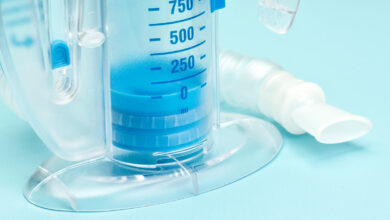Best Time of Day for Asthma Inhaler?

—
Small randomized trial suggests one has the biggest impact on nighttime asthma worsening
by
Crystal Phend, Contributing Editor, MedPage Today
April 15, 2025
- Asthma has a distinct daily rhythm, with the inflammatory cascade thought to start mid-afternoon as a cause of the known peak in airflow obstruction and airway inflammation overnight.
- In the small trial, once daily dosing in the afternoon yielded significantly better lung function at night than a single morning dose or medication split between morning and evening.
- Clinical asthma control was similar between groups, but that endpoint might require a larger trial to prove an impact.
For mild to moderate asthma, mid-afternoon dosing of inhaled beclomethasone suppressed nocturnal lung function worsening compared with other dosing strategies, a small open-label trial showed.
A single 400-μg dose at 3 to 4 p.m. improved nighttime forced expiratory volume in 1 second (FEV1 at 10 p.m.) by a median 160 mL compared with baseline whereas it fell by 20 mL from baseline with the same dose given at 8 to 9 a.m. and increased by 80 mg with twice daily dosing (P<0.01).
An afternoon dose also yielded significantly better overnight (10 p.m. to 4 a.m.) suppression in blood eosinophil counts as a marker of airway inflammation compared with the other two groups, although overall asthma control remained comparable across chronotherapy groups.
“Our findings further support the hypothesis that the optimal timing of ICS [inhaled corticosteroid] administration is at 16:00, coincident with enhanced glucocorticoid sensitivity at that time,” Hannah Jane Durrington, MB BChir, PhD, of the University of Manchester in England, and colleagues reported in Thorax.
Asthma has a distinct daily rhythm, with the inflammatory cascade thought to start mid-afternoon as a cause of the known peak in airflow obstruction and airway inflammation overnight.
The group acknowledged that mid-afternoon dosing could be complicated in patients who already have adherence challenges but that it might overcome barriers as well by achieving efficacy with lower cost due to fewer doses a day.
“New strategies to manage this could be implemented leveraging smartphone applications, timed alarms, and adherence reminders that could be effective solutions ensuring patients consistently follow their prescribed regimens,” suggested Nicola Smallcombe, MBBS, of the Royal Free London NHS Foundation Trust, and Richard Edward Russell, MBBS, PhD, of King’s College London.
Lack of translation of the lung function and inflammation findings to better symptomatic control could have been due to short duration of follow-up, small numbers (25 randomized to sequential crossover, with 21 completing it), and relatively low symptom burden at baseline, “so there was no headroom for improvement,” Smallcombe and Russell wrote in an accompanying editorial.
“This is likely to be the case as it is noteworthy that no patients dropped out in either the run-in or wash-out periods when they were not taking ICS-containing medication, and it would usually be expected that an improvement of 170 ml in FEV1 would lead to a measurable symptomatic improvement,” the editorialists suggested.
While the trial included adults with a mild to moderate allergic asthma phenotype, afternoon dosing “is most likely to benefit those with more severe asthma, where marginal gains in lung function and a reduced eosinophil count are more likely to translate into better control and risk reduction,” Smallcombe and Russell added.
Also, guidelines now recommend combined inhaled corticosteroid and long-acting beta agonist (LABA) inhalers as the standard of care, they noted. “The results of this current study need to be validated in a larger trial with longer follow-up, using LABA/ICS in real-world settings to best evaluate the feasibility and practical implementation.”
The trial recruited patients with physician-diagnosed mild to moderate allergic asthma who stopped their usual asthma treatment in the run-in period for 2 to 3 weeks. They then completed three-way cross-over periods of 28 days of treatment with beclomethasone dipropionate at 400 μg once daily between 8 and 9 a.m., 400 μg once daily between 3 and 4 p.m., and 200 μg twice daily between 8 and 9 a.m. and between 8 and 9 p.m. Participants all had similar typical sleep and wake times.
All regimens improved fractional exhaled nitric oxide and serum cortisol levels similarly. FEV1 comparisons didn’t differ significantly between groups at lung function checks at 4 a.m., 10 a.m., or 4 p.m.
“A future large, real-world chronotherapy study framed within the new asthma guidelines, using formoterol/ICS will determine if afternoon dosing leads to a reduction in exacerbations, better overall symptom control, health-economic benefits, and crucially, determine patient preference for afternoon dosing,” the researchers concluded.
Disclosures
The trial was supported by the JP Moulton Charitable Foundation.
Durrington disclosed no conflicts of interest. A co-author disclosed consulting fees from Aerogen, AstraZeneca, Boehringer Ingelheim, Chiesi, Cipla, CSL Behring, EpiEndo, Genentech, GSK, Glenmark, Gossamer Bio, Kinaset Therapeutics, Menarini, Novartis, Orion, Pulmatrix, Sanofi, Synairgen, Teva, Theravance Biopharma and Verona Pharma.
Smallcombe and Russell disclosed no relevant relationships with industry.
Primary Source
Thorax
Source Reference: Wang R, et al “The impact of dosage timing for inhaled corticosteroids in asthma: a randomised three-way crossover trial” Thorax 2025; DOI: 10.1136/thorax-2024-222073.
Secondary Source
Thorax
Source Reference: Smallcombe N, Russell RE “Chronotherapy in asthma: BD or not BD? That is the question” Thorax 2025; DOI: 10.1136/thorax-2025-223094.
![author['full_name']](https://assets.medpagetoday.net/media/images/author/crystalPhend_188.jpg)


